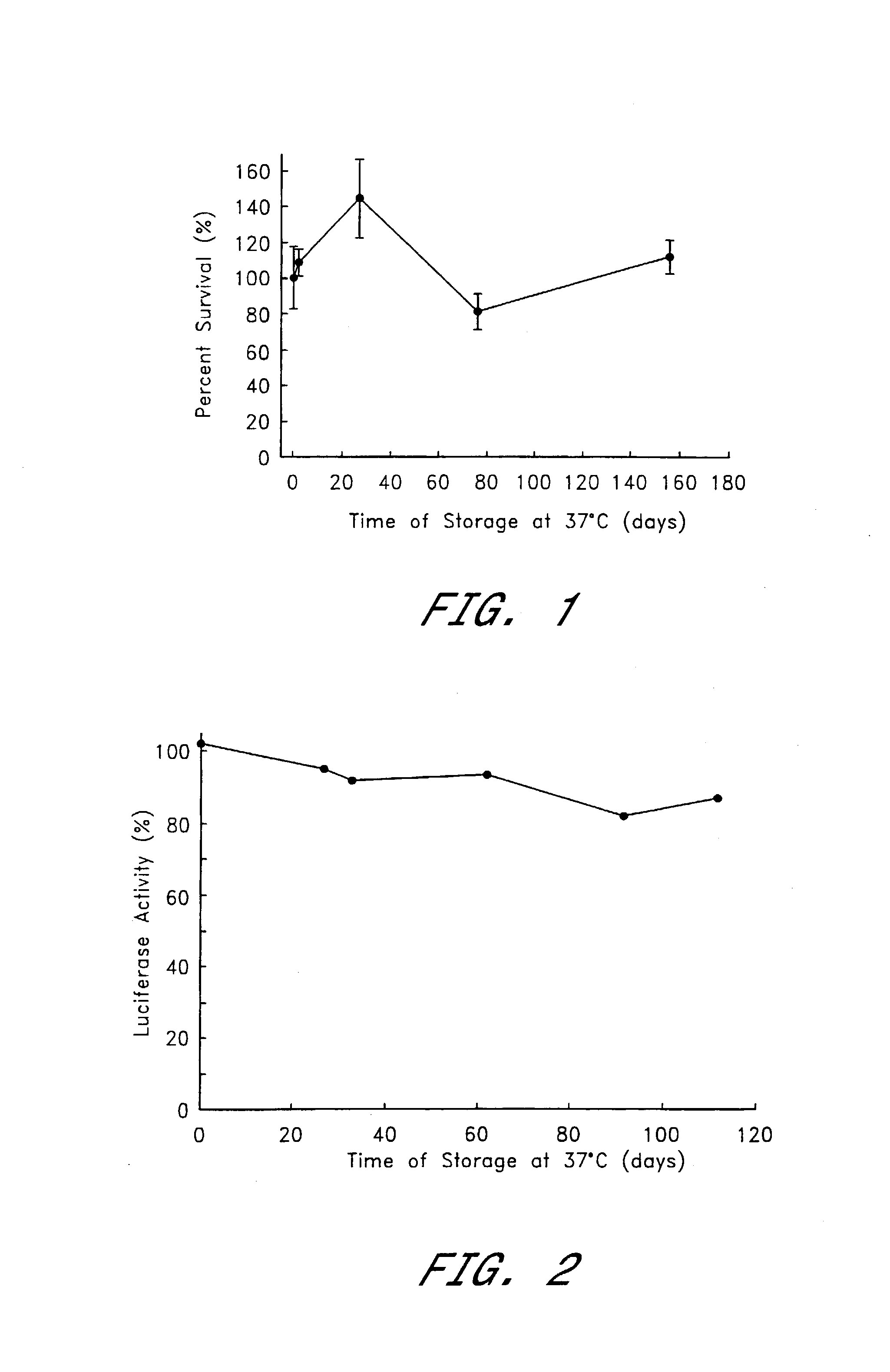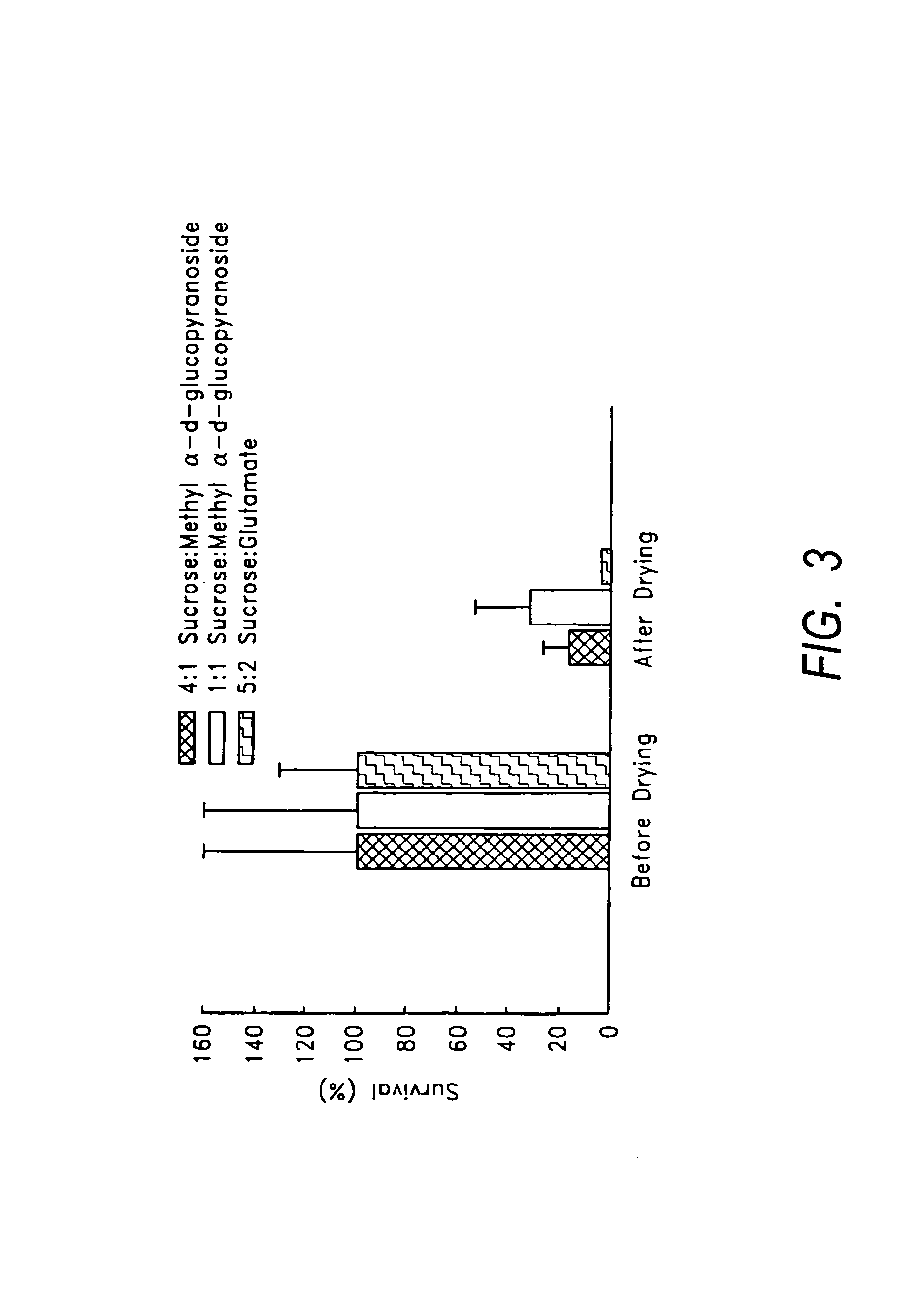Preservation and formulation of bioactive materials for storage and delivery in hydrophobic carriers
a bioactive material and hydrophobic technology, applied in the direction of microorganisms, disinfection, aerosol delivery, etc., can solve the problems of bioactive materials that are sensitive to degradation and loss of activity and/or viability in aqueous solutions, many bioactive materials require refrigeration or have short shelf life under ambient conditions, and many bioactive materials have only limited solubility in aqueous solutions. , to prevent back diffusion, low reactivity, low hydration
- Summary
- Abstract
- Description
- Claims
- Application Information
AI Technical Summary
Benefits of technology
Problems solved by technology
Method used
Image
Examples
example 1
[0085]An aqueous 50% glycerol isocitrate dehydrogenase solution from Sigma Chemical Co. containing 59.4 units of activity per ml was dialyzed for 5 hours in 0.1 M TRIS HCl buffer (pH 7.4). The activity of the isocitrate dehydrogenase in the 0.1 M TRIS HCl solution after dialysis was 26±1.8 units per ml. The activity decrease was associated with a decrease in the enzyme concentration because of dilution during the dialysis.
[0086]A mixture (100 l) containing 50 l of 50% by weight sucrose solution and 50 l of the isocitrate dehydrogenase suspension in 0.1 M TRIS HCl buffer (pH 7.4) was placed in 1.5 ml plastic tubes and preserved by drying at room temperature. First, the samples were dried for 4 hours under low vacuum (0.2 atm). Second, the samples were boiled during 4 hours under high vacuum (<0.01 atm). During this step, a mechanically stable dry foam was formed in the tubes. Third, the samples were stored during 8 days over DRIERITE under vacuum at room temperature.
[0087]After 8 day...
example 2
[0088]A mixture (100 l) containing 50 l of 50% by weight sucrose and 50 l of an ice nucleating bacteria suspension, (INB) Pseudomonas Syringae ATCC 53543, were placed in 1.5 ml plastic tubes and preserved by drying at room temperature. First, the samples were dried for 4 hours under low vacuum (0.2 atm). Second, the samples were boiled during 4 hours under high vacuum (<0.01 atm). After boiling under high vacuum, a mechanically-stable porous structure was formed. Third, the samples were stored during 8 days over DRIERITE under vacuum at room temperature.
[0089]After 8 days, the samples were rehydrated with 500 l water. Rehydration of the samples containing the dry foams was an easy process that was completed within several seconds. Then the samples were assayed for ice nucleation activity in comparison with control samples. There was no significant difference between the ice nucleating activity per 1,000 bacteria in the samples preserved by the present method versus the control sampl...
example 3
[0090]A sample containing a 1:1 mixture of a concentrated suspension of ice nucleating bacteria (INB) Pseudomonas Syringae ATCC 53543 and sucrose has been used. The sample was mixed until all sucrose crystals were dissolved, so that the final suspension contained 50 wt % sucrose. The suspension was placed in 20 ml vials at 2 g per vial. The vials were dried inside a vacuum chamber. The vials were sitting on the surface of a stainless steel shelf inside the chamber. The shelf temperature was controlled by circulating ethylene glycol / water antifreeze at a controlled temperature inside the shelf. Before the vacuum was applied the shelf temperature was decreased to 5 C. Then, the hydrostatic pressure inside the chamber was decreased to 0.3 Torr. Under these conditions the suspension boiled for 30 min. The temperature of the shelf was then slowly (during 30 min) increased up to 25 C. Visually stable dry foams inside the vials under these experimental conditions were formed within 3 hours...
PUM
| Property | Measurement | Unit |
|---|---|---|
| Temperature | aaaaa | aaaaa |
| Fraction | aaaaa | aaaaa |
| Fraction | aaaaa | aaaaa |
Abstract
Description
Claims
Application Information
 Login to View More
Login to View More - R&D
- Intellectual Property
- Life Sciences
- Materials
- Tech Scout
- Unparalleled Data Quality
- Higher Quality Content
- 60% Fewer Hallucinations
Browse by: Latest US Patents, China's latest patents, Technical Efficacy Thesaurus, Application Domain, Technology Topic, Popular Technical Reports.
© 2025 PatSnap. All rights reserved.Legal|Privacy policy|Modern Slavery Act Transparency Statement|Sitemap|About US| Contact US: help@patsnap.com



